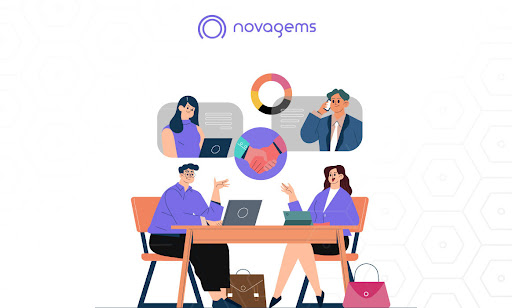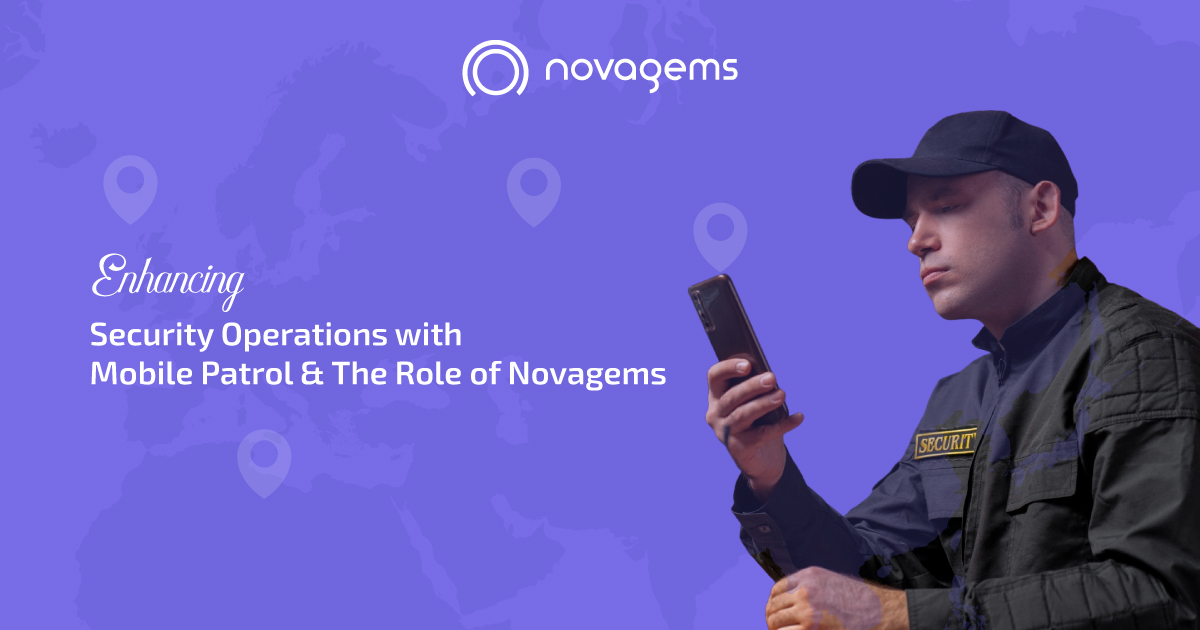Work Efficiency v/s Productivity – The Difference and Why it Matters?
Published on: Tue, Feb 13, 2024
Last updated: 2025-09-08
Read in 9 minutes

Key Takeaways
- Productivity measures how much work gets done, while efficiency measures how well it’s done.
- Both are essential — but focusing too much on one can harm the other.
- Efficiency improves quality and reduces waste; productivity increases output and speed.
- Tools, processes, and training help teams balance both effectively.
- Platforms like Novagems make it easy to track and improve both metrics in real time.
Introduction
In today’s fast-paced work environment, it’s easy to blur the lines between being productive and being efficient. Managers often praise “productivity,” but if that productivity comes at the cost of wasted time, burnout, or low quality — is it really success?
Understanding the difference between work efficiency and productivity is more than a vocabulary exercise; it’s the foundation of smarter business growth.
This guide breaks down both concepts, explores how they connect, and shares actionable strategies to improve them — backed by modern tools and real-world examples.
In the changing world of technology, workplaces strive to have an efficient and productive workforce. They are the two things that are crucial for the success of any organization. Efficiency is the driving force behind any productive employee. And people often confuse them both.
There is a difference in both that leaves many confused. Although they are not wary from a large amount, understanding the key factors will be beneficial. Work efficiency focuses on optimizing processes and workflows. This helps to achieve tasks with minimal wasted effort or resources. While productivity emphasizes delivering results that align with organizational goals. These changing times are all about working smarter and not harder. With less input the organizations have efficiency in the workplace.
You can easily maximize the output with minimal input. Both the individuals and organizations have increased productivity with more job satisfaction. With increased productivity efficiency can be achieved and vice versa. Productivity is measuring the quality and quantity of the work delivered. It sets clear objectives, goals and delivers results over a specific period of time.
Minimal Input = Maximum Output
Defining Work Efficiency
It refers to how effectively resources are utilized to achieve a particular outcome. Simply put, it’s a measure of doing things right. If your tasks are being completed in the given timeframe with less effort and resources. It focuses on optimizing the workflow and process of the company. If the tasks are assigned in a timely manner without any unnecessary delays or hookups.
You can always use software to automate complex tasks. If the tasks are assigned based on individuals strengths so that they can focus on most important tasks first.
Defining Productivity
It refers to the total amount of valuable work completed within a specific time frame. In essence, it’s about doing the right things. It emphasizes achieving goals and delivering results effectively, regardless of the time or effort expended. If there are no distractions while the staff is working then automatically there is a productive workforce. Increase the productivity of the whole company with the efficient and working employees.
What all efforts are put into, the outcome will be depending on that. If the input of the efforts is positive, you will have a positive outcome as well.
Understanding the Key Differences between Work Efficiency and Productivity
One of the key factors that will help you in defining the right balance in work efficiency and productivity is time management. If the individuals working in your company have a good grasp of effective management of time, they can manage their tasks well. Time theft and employee burnout are common factors that aid in a less productive workforce. An employee monitoring software can help you in that.
The system will not only track the staff but gauge their activities and time spent in completing the said tasks. It’s all about getting the stuff done and getting it done well. With proper efficiency in the workplace you need to know the smartest and the quickest way to get the outcome. If you are getting the work done without wasting any resources and time then you can count the work as efficient.
When we talk about productivity, let’s understand it with an example. Imagine you have a list of chores to do. To get a productive outcome you will tackle the work that is most difficult first or in an order the best way you can. It’s not just about finishing quickly; it’s about doing a good job.
Focus: Quantity vs. Quality
One of the most effective ways to increase the productivity is through effective time management. By prioritizing tasks, setting realistic deadlines, and minimizing distractions, individuals can make the most of their time and accomplish more in less time. When it comes to focus, you can either focus on quantity – getting a lot done – or focus on quality – doing a really good job. Both ways of focusing have their place, depending on what you’re trying to accomplish.
The organizations need to have knowledge of proper time management so that they can focus on quantity and quality. If desired outcomes are given then you have the right amount of quantity achieved. If the final outcome is exceeding the expectations then that means you have good quality of work done. The company can increase productivity if they have a proper balance between the two.
Identify Key Performance Indicators
The most sure and effective way to measure the productivity and efficiency of employees is through Key Performance Indicators (KPIs). These help you measure the completed tasks alongside accuracy. You can even check the quality of the work with time taken to complete the task. KPI’s can change from company to company depending upon the goals of the company.
If you are setting any KPS make sure they are easy to measure and easy to achieve. Also you will need to make sure that they are regularly measured and kept track of. Also make sure that the employees know and they can measure their performance and growth accordingly as well.
Resource Management: Input vs. Output
The main goal of an organization is to get the maximum output with minimum input. How can a company achieve their goal without wasting unnecessary time or resources. If these things are not measured properly this can lead to employee burnout.
Happy employees = productive employees
If your employees are feeling motivated and happy in the workplace environment then they will think less of switching as well. Focuses mainly on the output (amount of work completed), with the input being a secondary concern.
Measuring Success
Now let’s talk about the main thing. Measuring success. It is not easy to juggle many things at once. With proper time management efficiency in the workplace can be achieved. Measured by metrics like time spent on a task, resource utilization rates, and error rates. These are the sure factors that will aid you.
Measuring efficiency in the workplace is a tricky thing to measure as there are many external factors affecting employees productivity. Combining both efficiency and productivity leads to better outcomes. By using resources wisely (efficiency) and focusing on achieving the right objectives (productivity), you can ensure optimal results. Understanding the difference allows you to allocate resources effectively and avoid overloading employees, leading to improved decision-making.
How to Improve Work Efficiency
Efficiency is about reducing waste — of time, effort, or resources — without sacrificing quality.
Here’s how to make your team more efficient:
1. Map and Streamline Processes
Identify every step in your workflow and remove redundancies. Use flowcharts or process-mapping tools to spot bottlenecks and automate repetitive tasks.
2. Use Standardized Checklists and Templates
Consistency saves time. Create digital templates for recurring tasks — like cleaning audits, reports, or maintenance logs.
Platforms like Novagems let you standardize these checklists across teams and sites.
3. Train Smarter, Not Harder
Well-trained employees complete tasks correctly the first time. Regular refresher sessions on procedures, safety, and communication reduce costly mistakes.
4. Automate Repetitive Work
Automation is the key to sustainable efficiency.
Use software to handle scheduling, attendance tracking, or report submission — freeing supervisors for higher-value tasks.
See how Novagems’ Smart Scheduling automates shift planning and real-time tracking.
5. Monitor Resource Utilization
Track how time, materials, and manpower are being used. Regular analysis can reveal hidden inefficiencies such as overtime spikes or task overlaps.
💡 Pro Tip: Encourage employees to share suggestions for improving workflows. Frontline insights often lead to the biggest efficiency gains.
How to Improve Productivity
Productivity is about maximizing output — getting more done in the same or less time.
Here’s how to boost productivity without overloading your team:
1. Set Clear, Measurable Goals
Use SMART goals (Specific, Measurable, Achievable, Relevant, Time-bound).
When employees know exactly what’s expected, focus and motivation rise.
2. Use Time Management Techniques
Adopt proven frameworks like time blocking, Pomodoro, or Eisenhower matrices to prioritize high-impact tasks.
Encourage staff to focus on one task at a time — multitasking often lowers true productivity.
3. Leverage Technology
Digital tools are productivity multipliers.
Use dashboards that show real-time metrics for attendance, progress, and reports — giving managers complete visibility.
Novagems Cleaning Management Software combines scheduling, reporting, and team communication in one place.
4. Minimize Distractions
Unnecessary meetings, unclear instructions, and cluttered communication kill productivity. Keep meetings short and structured. Use one platform for all internal updates to reduce confusion.
5. Track and Reward Results
Measure productivity through KPIs like tasks completed per shift, time to completion, or output quality.
Recognize high performers — public appreciation fuels motivation and productivity.
Balancing Efficiency and Productivity
Here’s the real secret: success isn’t about choosing one over the other — it’s about finding balance.
- Too much focus on productivity can cause burnout, errors, and turnover.
- Too much focus on efficiency can slow output and stifle innovation.
The ideal balance depends on your goals. For example:
- If your cleaning company is expanding rapidly, focus on productivity first — get more jobs done.
- Once operations stabilize, focus on efficiency — reduce wasted effort, standardize workflows, and improve client satisfaction.
By using real-time tracking tools like Novagems, you can monitor both productivity (output metrics) and efficiency (resource utilization, compliance, quality) simultaneously.
Conclusion
Work efficiency and productivity are two sides of the same coin, each playing a crucial role in achieving success. While work efficiency focuses on optimizing processes and workflows, productivity emphasizes delivering results that align with organizational goals. So, whether you’re aiming to increase the productivity, improve time management, or enhance overall work efficiency, remember that mastering both is the key to unlocking your full potential.
FAQs
Q1. Can you be productive but not efficient?
Yes. For example, a team can complete many tasks (productive) but waste resources or make errors (inefficient).
Q2. What’s more important — efficiency or productivity?
Both are vital. Focus on productivity to grow; focus on efficiency to sustain that growth long-term.
Q3. How can I measure work efficiency?
Compare actual performance against ideal output using time, cost, and quality as metrics. Tools like Novagems simplify this tracking automatically.
Q4. How do I balance both in my business?
Start by automating manual tasks, training staff, and reviewing KPIs weekly to adjust for performance or resource waste.
Get a Free Trial
Sign up For Newsletter
Latest Blog Posts
Get Started
Start being productive & grow your business
with Novagems





